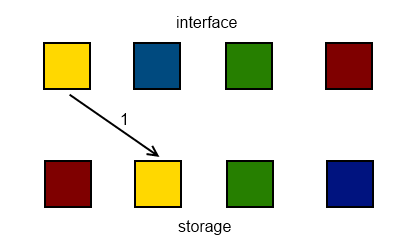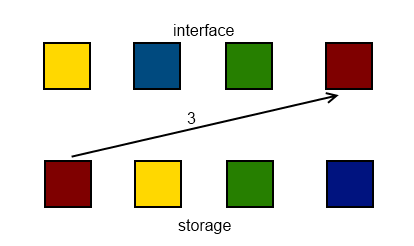Size matters, part 3
In part 2 we got our types sorted properly for optimal layout. The next step is building the mappings to and from the storage indices.
Before we start, I need to make clear what these mappings are. The code can be quite confusing and difficult to follow without a clear idea of this.
When we have a call like get<0>(some_tuple) we need to know where in the storage is the element 0, since we may have relocated it to get our optimal layout. In the picture below, we can see an example where the element 0 is at position 1 in storage. We need to map index 0 from the interface to index 1 in the storage.

That would mean that our representation of this map, being merely a list of indices, would store in position 0 the value 1: indices<1, x, y, z>. Applying the same logic to the other elements, we would have indices<1,3,2,0>.
This map is not enough, though. If we have a call to make_tuple(a, b, c, d), we need to rearrange these arguments to place each one at the appropriate spot. To call the constructor for the tuple that we use for storage, we need to figure out which of those arguments to place at index 0, so we can pass it as the first argument of that constructor.

The picture shows that at index 0 we would place the object that was given at position 3. The previous map does not readily provide this information. We need one that gives us a 3 in position 0, and so on for the other elements. For this example, that map would be indices<3,0,2,1>.
Mapping from interface to storage
After sorting, we have a type list that might look like the following.
using sorted_example = std::tuple<
indexed<layout<1>, 1>
indexed<layout<2>, 3>,
indexed<layout<4>, 2>,
indexed<layout<4>, 0>,
>This type contains information about the order of the types, which we will need to define a std::tuple for storage; and also the indices for the map from the interface indices to the storage indices, which we will need to write get. We just need to extract this information into a more appropriate format.
So far we needed to carry the types and indices together, and now we need to split them. Variadic templates actually make this task pretty easy. We can simply do some pattern matching in a partial specialization and take the two parameter packs at once. Then we repack them separately in two different types.
template <typename List>
struct split;
template <typename... T, std::size_t... I>
struct split<std::tuple<indexed<T, I>...>> {
using tuple = std::tuple<T...>;
using map = indices<I...>;
};
template <typename List>
class optimal_order {
using sorted = Sort<WithIndices<List>>;
using tuple = typename split<sorted>::tuple;
using to_storage = typename split<sorted>::map;
//using to_interface = ...;
};
template <typename... T>
using Storage = typename optimal_order<std::tuple<T...>>::tuple;
template <typename... T>
using MapToStorage =
typename optimal_order<std::tuple<T...>>::to_storage;One map down, one to go. The other map is a bit trickier. We could implement it by simply searching for the position of each index in the map we already built. A naive approach would result in O(N2) template instantiations, but we can avoid that and keep everything compiling with linear instantiations.
Convincing overload resolution to do our work for us
Instead of writing a template to search for indices, we can use overload resolution to do that search for us. When we pass a type that inherits from multiple bases into a function with different overloads for each base, the compiler considers all those overloads as possible for the call. If those overloads are template functions, we can narrow down the possibilities by making some template parameters explicit. We can take advantage of this to do our search and don't need to write our own with recursive template instantiations.
For this to work, we need a type that derives from all the candidates for our search. That is not difficult to produce using variadic templates.
template <typename List>
struct inherit_all;
template <typename... T>
struct inherit_all<std::tuple<T...>> : T... {};We will use only our empty TMP types, so we can inherit from them directly. If there was a possibly of having fundamental types, references, etc, we would need some sort of wrapper because we cannot inherit from those.
I should also note that there is no risk for ambiguity here: we know for certain that all types are different specializations of indexed and each one has a different index.
Now we need a function template that accepts all our candidates. Those candidates need to carry around their positions in the map we have already computed. We can use our indexed and WithIndices templates for this.
template <typename T, std::size_t I, std::size_t J>
using indexed2 = indexed<indexed<T, I>, J>;This parameter of our function template will be built from this template. It actually has information we don't need (the type), but that is not problematic, and it has the advantage that it can be built simply by attaching indices to our already sorted list.
template <std::size_t Target, std::size_t Result, typename T>
index<Result> find_index_impl(indexed2<T, Target, Result> const&);Note how the index we are looking for is the first template parameter. This is so we can pass it explicitly, and still have the compiler deduce the rest. The type deduction is crucial here: it is how we get our result back. We put that result into the return type so we can obtain it easily with decltype.
template <std::size_t Target, typename List>
struct find_index
: decltype(find_index_impl<Target>(inherit_all<List>{})) {};With this we can write find_index<0, sorted_example>::value and obtain 3, and we have a constant number of template instantiations.
Putting it all together
To put everything together we need to apply find_index to all indices from 0 to N-1, where N is the number of types involved. This can be done easily if we have a IndicesFor alias that builds a list of indices with the same size as a given tuple. I will leave that as an exercise for the reader.
template <typename List, typename Indices = IndicesFor<List>>
struct map_to_interface;
template <typename List, std::size_t... I>
struct map_to_interface<List, indices<I...>>
: identity<indices<find_index<I, List>::value...>> {};
template <typename List>
class optimal_order {
//using sorted = ...;
// ...
using to_interface = typename map_to_interface<WithIndices<sorted>>::type;
};
template <typename... T>
using MapToInterface =
typename optimal_order<std::tuple<T...>>::to_interface;The lower level
And we finally have enough machinery in place to start the actual tuple class. So far everything was done on the metaprogramming level, but the next post in this series will finally involve a bit at the "regular" program level.